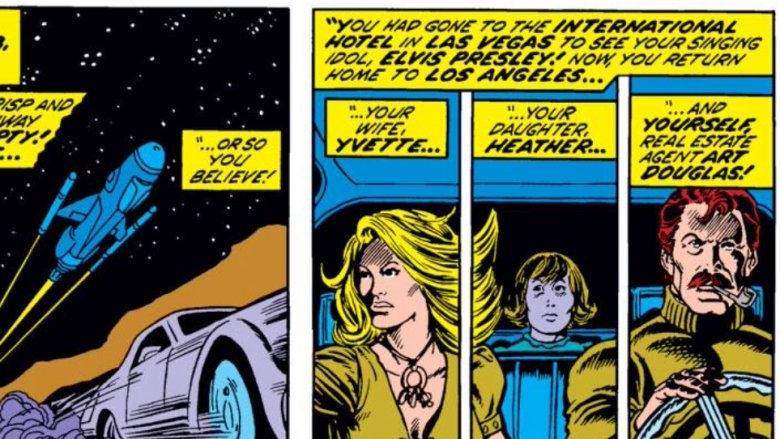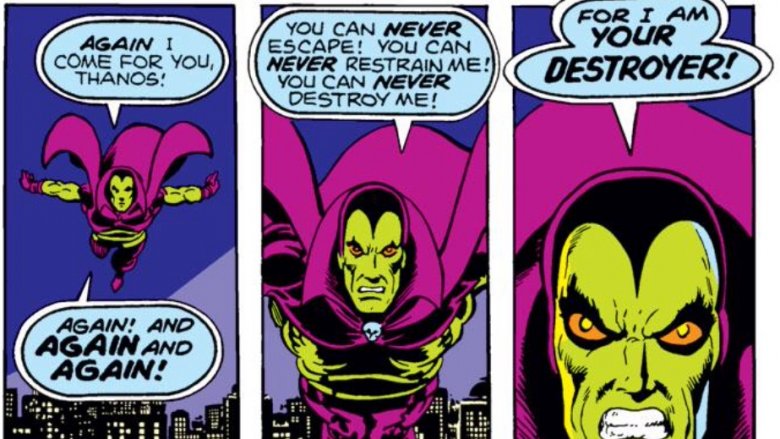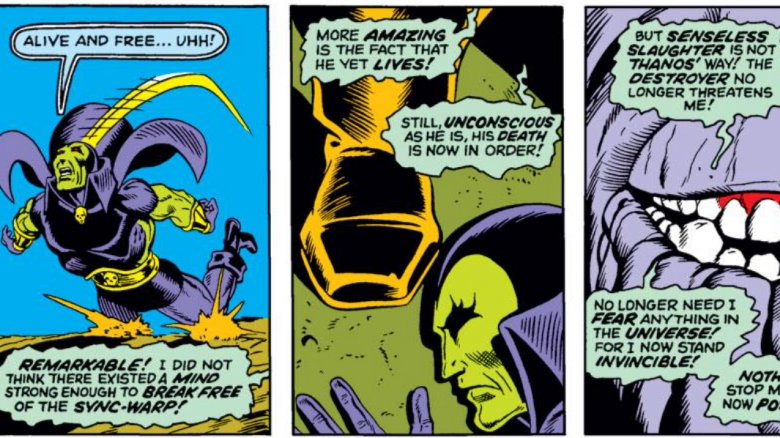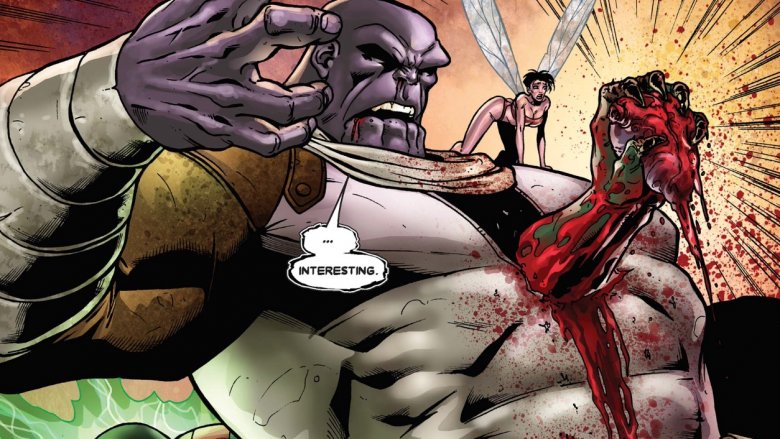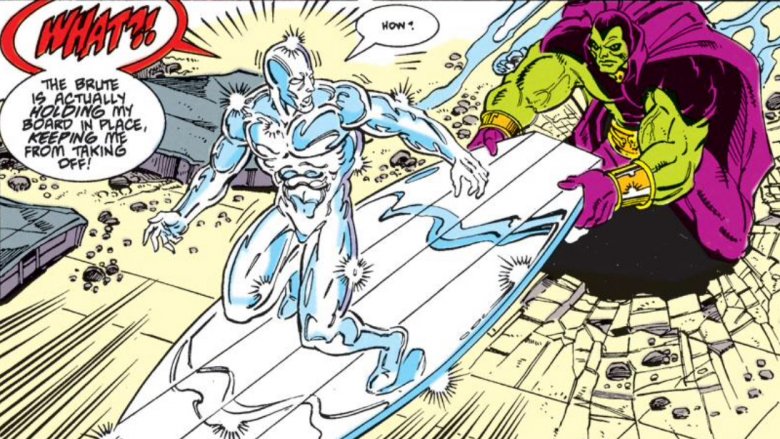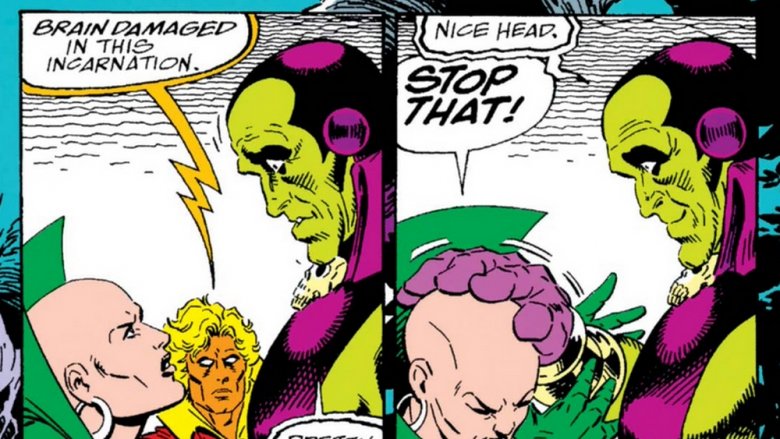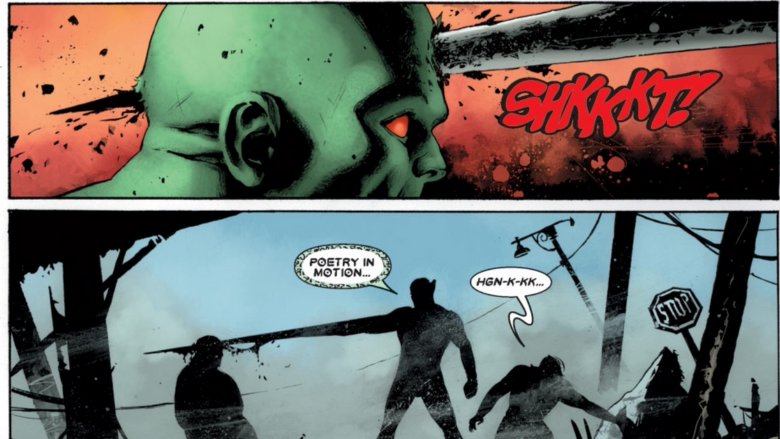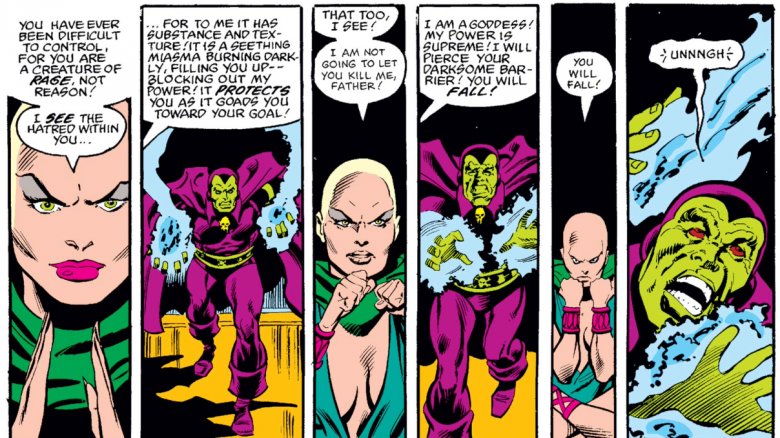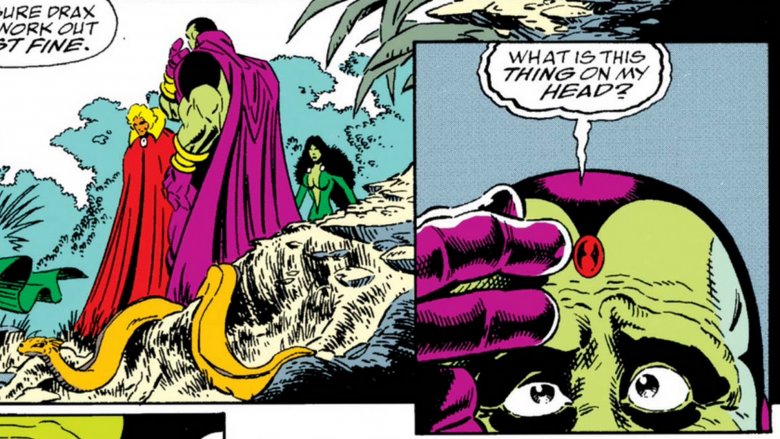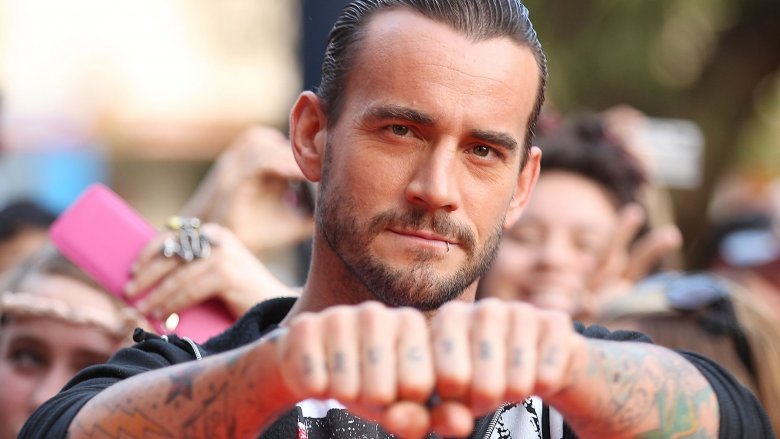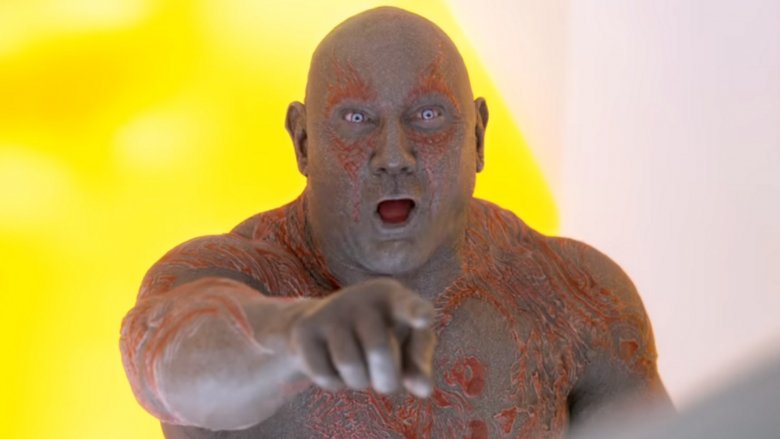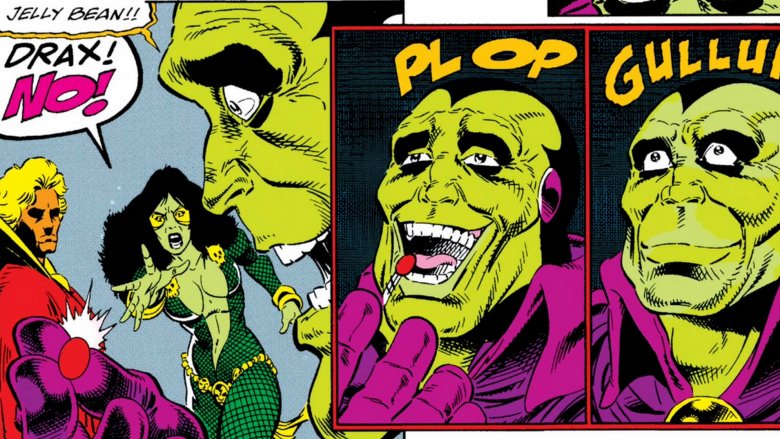The Untold Truth Of Drax The Destroyer
It's pretty common that comic book heroes and villains have to be altered, at least a little, when transported to the big screen. But the differences never seemed so fitting than in the case of Drax the Destroyer, whose very nature is one of change. Since he first appeared in 1973's Iron Man #55, Drax has weathered drastic shifts in intelligence, temperament, and physical power. He's been one of Marvel's most powerful heroes; he's been one of its dumbest. He's been custodian of one of the Infinity Stones (the same one he and his comrades took from Ronan in Guardians of the Galaxy, in fact), and he's had emotional breakdowns over mint cookies. He's died and been reborn so many times, often the writers don't even bother explaining his most recent resurrection. So the fact that Dave Bautista's Drax in the Marvel movies isn't always in sync with the Drax in the panels is, weirdly, kind of in sync with the Drax of the panels.
Those transformations, rebirths, deaths, quirks, and differences between page and screen can be found in the untold truth of Drax the Destroyer.
Drax is from Earth
Drax's origin was told in 1974's Captain Marvel #32, written by Jim Starlin (creator of Drax and Thanos). In the issue, we learn that Drax is no alien whose people misunderstand metaphor. Drax, in fact, is from Earth. Before his death at the hands of the uncaring Thanos, Drax's name was Arthur Douglas. He lived in Nevada with his wife Yvette and his daughter Heather.
Douglas and his family had the bad luck to be driving down the road during Thanos' first scouting mission to Earth. Thanos had no idea whether or not anyone in the car had seen his ship, but he attacked all the same, not wanting to leave anything to chance. Arthur and his wife Yvette died. Unbeknownst to anyone, their daughter Heather escaped.
At about the same time, on the moon Titan, Thanos's father Mentor called out to Kronos — father of the gods — for help in stopping the plans of his wayward son. Kronos obliged Mentor and built a super powerful body from the earth, and in the body he placed the now vengeful soul of Arthur Douglas.
You had ONE job
In the first Guardians of the Galaxy film, Drax is on a mission to kill Ronan the Accuser for the murder of his family. At the end of the film, with Ronan dead, Gamora congratulates him. Drax dismisses this, saying that Ronan was just a puppet and it's really the puppetmaster — Thanos — that he needs to kill.
With this, Dave Bautista's Drax grew closer to the source material.
Drax the Destroyer's sole purpose is the death of Thanos. When Kronos built his body and placed inside it the soul of Arthur Douglas, he programmed Drax with a singular mission of ending the threat of Thanos.
In Drax's earliest appearances, his obsession with Thanos is so intense that he can be as much of a liability to the heroes fighting Thanos as a help. He cares little about plans, schemes, or strategies — he simply throws himself at the Mad Titan. When he reappeared after a long absence in 1990's Silver Surfer #37, shortly before Infinity Gauntlet, he attacked everyone in sight, screaming "Where's Thanos?" over and over, not listening or caring when it was clear no one knew the answer.
He was bad at his job...
Even though destroying Thanos is Drax's sole purpose, even with the title of "The Destroyer," and even though Drax is — even in his least powerful incarnations — a fairly powerful guy, he isn't particularly good at his job.
To be fair to poor Drax, often he doesn't manage to attack Thanos until the villain is pumped up with some Marvel god-engine artifact — like when he fought a Thanos powered by the Cosmic Cube in Captain Marvel #32, or when he was the first of the gaggle of heroes who throw themselves at Thanos in Infinity Gauntlet #4, long after Thanos has claimed all six Infinity stones — to get taken out of the fight.
But even when the Mad Titan hasn't been fueled by some cosmic bauble, Drax has seemed — at best — to provide a minor distraction. In a backup story in 1977's Logan's Run #6, Thanos laughs off Drax's most powerful attacks even though it's just plain ol' unleaded Thanos without a cube or a stone or anything else.
...Until he wasn't
Perhaps the thing Drax needed to finally accomplish his mission was for events to maneuver themselves in such a way that the last thing anyone would want was for Drax to accomplish his mission.
In 2006's Annihilation #4, after over three decades of trying and failing, after suffering a number of his own deaths and rebirths, Drax the Destroyer finally killed Thanos. Of course, he did it as Thanos was trying to save the galaxy by freeing Galactus from the villain Annihilus, and in killing Thanos, Drax stopped him from doing what needed to be done. But you can't really blame a guy for being persistent about doing a good job.
Of course, eventually the galaxy was saved from Annihilus. And four years later, in The Thanos Imperative, the Mad Titan would be resurrected — and in Thanos Imperative #4 he would have his revenge on Drax. Though his revenge would not prove any more permanent than Drax's.
A former heavy hitter
As far as his power is concerned, the Drax of the movies is fairly accurate to the Drax of the comics. You wouldn't want to arm wrestle him, but he isn't strong enough to feel safe getting on the Hulk's bad side.
But this wasn't always the case. The Drax who was resurrected just before Infinity Gauntlet quickly became one of Marvel's most powerful heroes. The Destroyer regularly held his own against the absolute A-list of Marvel tough guys — including Thor, the Silver Surfer, and the Hulk. If, in 1992, Superman were to drop by Marvel Town and start talking smack, you can bet Drax would be one of the first guys on Captain America's list to throw against Kal-el.
Along with having a lot more strength, the Drax of the comics used to have the power of flight — regularly flying through space without seeming to need any devices to breathe or keep himself warm — and could fire powerful energy blasts from his hands.
The Drax of the panels became more like what we see today in 2005's Drax the Destroyer miniseries. After being killed in the second issue, Drax was reborn smaller, less physically powerful, but with a much greater degree of intelligence.
He used to be an idiot
Perhaps Drax's most traumatic death was at the hands of his own daughter. Heather, a.k.a. Moondragon, used her mental powers to kill Drax in 1982's Avengers #220. When the Destroyer returned eight years later in Silver Surfer #35, his mind wasn't fully healed. The obsessed intergalactic warrior of the past seemed — though still intent on Thanos' destruction — a little more lovable and a lot dumber.
Just before Adam Warlock recruits Drax in Warlock & the Infinity Watch #2, Drax is busy smashing TV monitors on Titan because's he's angry the transmission of the earth show Alf has been interrupted. In Warlock & the Infinity Watch #13, when Drax tussles with the Hulk, the (then intelligent) Hulk is able to briefly get Drax to stop fighting by convincing Drax he's already won. In one fan favorite scene in 2000's Captain Marvel #4, Drax falls to his knees and screams "NOOOO!" because the Girl Scout he's found is out of mint cookies.
Moondragon confronted Drax's creator Kronos and managed to restore Drax's intelligence in 1995's Cosmic Powers Unlimited #4, but either the upgrade didn't take or the story was forgotten, because Drax was back to little kid mode in the 2000 Captain Marvel issues. His intelligence wasn't restored fully — or in a way that stuck — until 2005's Drax the Destroyer miniseries.
He dies. A lot.
When a hero dies in the second issue of their own four-issue miniseries, you know that either dying is something that isn't quite so permanent for them or someone needs to wake up the editor.
Of course, the idea of heroes dying and coming back multiple times isn't a new or rare one in superhero comics. In the case of Drax the Destroyer, though, death and rebirth are built into his DNA.
He died first in Avengers #220, when he tried to stop his daughter Moondragon from psychically enslaving an entire world. He came back to life in Silver Sufer #35 to face the coming threat of Thanos. This more powerful, less intelligent Drax met his end in Drax the Destroyer #2 when Paibok the Power Skrull stabbed him through the skull. In the following issue he was reborn as the more intelligent, but not quite as powerful Drax we see in the comics and on the big screen today. Still, Drax's time with death wasn't over. Unwilling to let go of his need to kill the Mad Titan, Drax once more tried to kill the newly resurrected Thanos in 2008's The Thanos Imperative #4, only to have Thanos kill him first.
Four years later when Drax showed up with the rest of the Guardians of the Galaxy in the pages of Avengers Assemble, no explanation was offered for his resurrection. Other than, you know, he was going to be in the movie.
Heather
Whether we ever see a similar reveal in the movies, in the comics, Drax eventually learned that his daughter Heather survived the attack that killed Arthur Douglas and his wife. Rescued by Thanos' father Mentor, Heather was brought to Titan and raised there.
Though Moondragon would eventually join the Avengers, the Defenders, the Infinity Watch, and even the Guardians of the Galaxy, she didn't always share the more heroic values of her comrades. While traveling the spaceways with Drax, she came across a planet immersed in war and solved the problem by mentally enslaving all the inhabitants. Drax contacted the Avengers for help, and eventually Moondragon killed her father when he tried to stop her.
Ever since, their relationship has been strange. When Warlock recruited Drax into the Infinity Watch in Warlock & the Infinity Watch #2, she immediately attacked Drax, fearing he would try to get revenge for his murder. She didn't know he still suffered brain damage, and didn't actually remember what had happened.
A cosmic custodian
The events of Infinity Guantlet – in which Marvel's heroes united to stop Thanos after he had gathered all the infinity gems — left the Infinity Gauntlet and its six Infinity Stones under the guardianship of Adam Warlock. Marvel's cosmic pantheon wasn't happy with this choice, however, and didn't think Warlock could handle such a responsibility, so Warlock chose five people to whom he gave the remaining gems. For himself, he kept the Soul gem.
In Warlock & the Infinity Watch #2, Warlock revealed the candidates for most of the other stones (with the exception of one — surprisingly, he entrusted Thanos with the reality gem). To Drax the Destroyer went the power stone, augmenting his already immense power. Warlock said he chose Drax because he would know better than most how to handle power.
Warlock would later question his decision-making, believing the power of the Infinity Gauntlet had corrupted his thinking. He gave the space gem to the mischievous Pip the Troll (who immediately used it to steal, among other things, an Avengers quinjet). He gave the mind stone to Moondragon, who had once used her powers to enslave an entire world. And of course he gave an infinity stone to Drax, who destroys things when he misses Alf.
Drax remained custodian of the power stone until it, along with the other stones, was stolen by the villain Rune.
CM Punk
Drax the Destroyer's most recent solo comics title — 2015's 11-issue Drax – was co-written by by former WWE and UFC star Phillip Jack Brooks, a.k.a. CM Punk. Angling for work on a Punisher book, he was offered Drax instead; Brooks said he liked the idea because he didn't have any "connection with the character — not like with Punisher."
When coming on board, Brooks didn't know much about Drax's recent history. "I was more familiar with the Jim Starlin Drax; Infinity Gauntlet, Infinity Watch, Infinity War. I wasn't too up on what Bendis had done with the character, so I did my homework."
Drax was a fun, hilarious, and action-packed comic with guest stars like Terrax the Tamer, the always fun Fin Fang Foom, and unbelievably a close-to-R-rated version of Planet Terry. Eventually, Brooks wanted to bring in Thanos, but unfortunately the series didn't last long enough.
A Drax solo movie?
In 2017, days before the release of Guardians of the Galaxy Vol. 2, CBR interviewed Dave Batista about his experience coming back to Drax for the second installment. During the conversation, Batista revealed that he wanted to eventually get to show audiences more about Drax's backstory.
"I'd also like for fans to be able to put a face to a name," Batista said. "I'd like them to be able to see Drax's family, and why he's heartbroken at the loss of his wife and his daughter."
Batista said he'd even talked to Guardians writer/director James Gunn about the possibility of a solo Drax project. He said while he'd like to see it happen, he doesn't necessarily think it's in the cards.
"We've even talked standalone movie possibilities," Batista told CBR. "I don't have high hopes for that. But I'd like to see it happen. Really just because I think Drax has an interesting story. I think people would like to hear more about it. If it doesn't happen as a standalone film, that's a super longshot. They've got their slate, and I totally get it."
Famously huge
The movie Drax is an alien, while the comic book Drax is an earthling who was forced into a constructed body. This means there are a number of differences between them. One of the more surprising differences? Well. There's a specific bodily function comic book Drax doesn't have to worry about.
In the beginning of Guardians of the Galaxy Vol. 2, Rocket threatens to put a turd in Peter Quill's pillow while he sleeps. Quill assumes this means Rocket will use his own turd. Rocket corrects him, saying it will be one of Drax's. At this, Drax lets out one of his huge belly laughs, boasting, "I have famously huge turds!"
Not according to the comics.
In Warlock & the Infinity Watch #2, when Adam Warlock gives Drax the power stone, Drax doesn't know what it is. He thinks it's a jelly bean, so he eats it. Understandably, Gamora freaks out, and Warlock tries to reassure her, reminding her that the stone is indestructible and won't digest. When she continues to protest, Warlock says, "Drax's physical being is unlike most creatures. I'll explain later. Trust me, he won't lose it."
In other words, Drax doesn't poop.
Use one of your own, trash panda.
